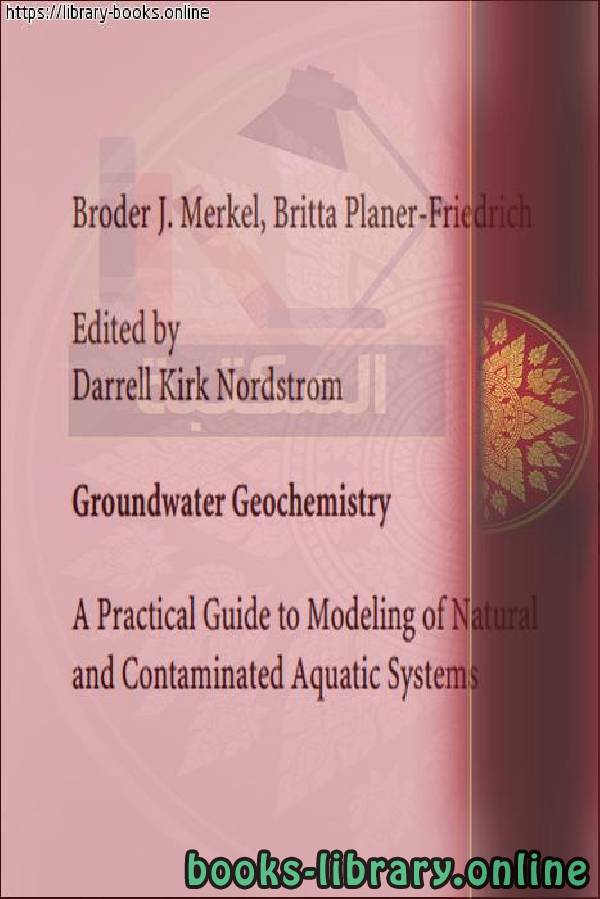❞Broder J. Merkel❝ المؤلِّف - المكتبة
- ❞Broder J. Merkel❝ المؤلِّف - المكتبة
█ حصرياً جميع الاقتباسات من أعمال المؤلِّف ❞ Broder J Merkel ❝ أقوال فقرات هامة مراجعات 2025 ❰ له مجموعة الإنجازات والمؤلفات أبرزها Groundwater Geochemistry ❱
إنضم الآن وتصفح بدون إعلانات
له مجموعة من الإنجازات والمؤلفات أبرزها ❞ Groundwater Geochemistry ❝
#11K
0 مشاهدة هذا اليوم#29K
12 مشاهدة هذا الشهر#25K
2K إجمالي المشاهدات كتاب Groundwater Geochemistry 2005
نبذه عن الكتاب: Theoretical Background.........................................................................1 1.1 Equilibrium reactions....................................................................................1 1.1.1 Introduction...........................................................................................1 1.1.2 Thermodynamic fundamentals..............................................................4 1.1.2.1 Mass action law.............................................................................4 1.1.2.2 Gibbs free energy ..........................................................................6 1.1.2.3 Gibbs phase rule............................................................................7 1.1.2.4 Activity..........................................................................................8 1.1.2.5 Ionic strength.................................................................................8 1.1.2.6 Calculation of activity coefficient ...............................................10 1.1.2.6.1. Theory of ion dissociation.................................................10 1.1.2.6.2. Theory of ion interaction...................................................12 1.1.2.7 Theories of ion dissociation and ion interaction..........................14 1.1.3 Interactions at the liquid-gaseous phase boundary..............................17 1.1.3.1 Henry-Law ..................................................................................17 1.1.4 Interactions at the liquid-solid phase boundary...................................18 1.1.4.1 Dissolution and precipitation.......................................................18 1.1.4.1.1. Solubility product..............................................................18 1.1.4.1.2. Saturation index.................................................................20 1.1.4.1.3. Limiting mineral phases ....................................................22 1.1.4.2 Sorption.......................................................................................24 1.1.4.2.1. Hydrophobic /hydrophilic substances ...............................24 1.1.4.2.2. Ion exchange......................................................................24 1.1.4.2.3. Mathematical description of the sorption ..........................30 1.1.5 Interactions in the liquid phase ...........................................................34 1.1.5.1 Complexation ..............................................................................34 1.1.5.2 Redox processes..........................................................................36 1.1.5.2.1. Measurement of the redox potential ..................................36 1.1.5.2.2. Calculation of the redox potential .....................................37 1.1.5.2.3. Presentation in predominance diagrams ............................41 1.1.5.2.4. Redox buffer......................................................................45 1.1.5.2.5. Significance of redox reactions .........................................46 1.2 Kinetics.......................................................................................................49 1.2.1 Kinetics of various chemical processes...............................................49 1.2.1.1 Half-life.......................................................................................49 1.2.1.2 Kinetics of mineral dissolution....................................................50 1.2.2 Calculation of the reaction rate ...........................................................51 1.2.2.1 Subsequent reactions...................................................................52 VIII Table of contents 1.2.2.2 Parallel reactions .........................................................................53 1.2.3 Controlling factors on the reaction rate...............................................53 1.2.4 Empiric approaches for kinetically controlled reactions.....................55 1.3 Reactive mass transport ..............................................................................57 1.3.1 Introduction.........................................................................................57 1.3.2 Flow models........................................................................................57 1.3.3 Transport models ................................................................................57 1.3.3.1 Definition ....................................................................................57 1.3.3.2 Idealized transport conditions .....................................................58 1.3.3.3 Real transport conditions.............................................................60 1.3.3.3.1. Exchange within double-porosity aquifers ........................61 1.3.3.4 Numerical methods of transport modeling ..................................63 1.3.3.4.1. Finite-difference / finite-element method..........................63 1.3.3.4.2. Coupled methods...............................................................65 2 Hydrogeochemical Modeling Programs .............................................67 2.1 General........................................................................................................67 2.1.1 Geochemical algorithms .....................................................................67 2.1.2 Programs based on minimizing free energy........................................69 2.1.3 Programs based on equilibrium constants...........................................70 2.1.3.1 PHREEQC...................................................................................70 2.1.3.2 EQ 3/6 .........................................................................................72 2.1.3.3 Comparison PHREEQC – EQ 3/6...............................................73 2.1.4 Thermodynamic data sets....................................................................76 2.1.4.1 General ........................................................................................76 2.1.4.2 Structure of thermodynamic data sets .........................................78 2.1.5 Problems and sources of error in geochemical modeling....................80 2.2 Use of PHREEQC.......................................................................................84 2.2.1 Structure of PHREEQC under the Windows surface..........................84 2.2.1.1 Input ............................................................................................85 2.2.1.2 Thermodynamic data...................................................................93 2.2.1.3 Output..........................................................................................94 2.2.1.4 Grid .............................................................................................95 2.2.1.5 Chart............................................................................................95 2.2.2 Introductory Examples for PHREEQC Modeling...............................95 2.2.2.1 Equilibrium reactions ..................................................................95 2.2.2.1.1. Example 1: Standard output – seawater analysis...............96 2.2.2.1.2. Example 2 equilibrium – solution of gypsum....................98 2.2.2.2 Introductory examples for kinetics..............................................99 2.2.2.2.1. Defining reaction rates ....................................................100 2.2.2.2.2. BASIC within PHREEQC...............................................103 2.2.2.3 Introductory example for reactive mass transport .....................106
عدد المشاهدات
3714
عدد الصفحات
207
نماذج من أعمال Broder J. Merkel:


